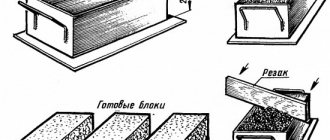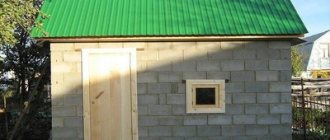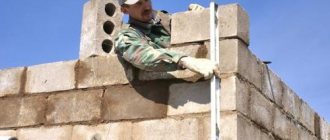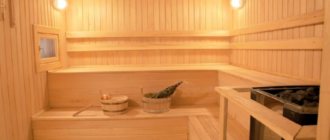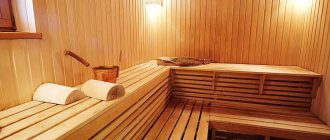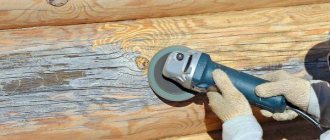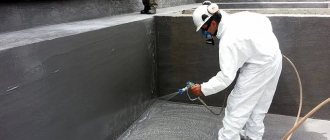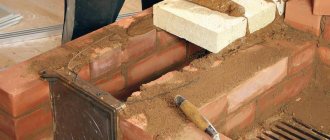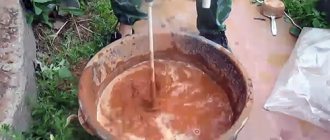A cinder block is a building product that is manufactured industrially or by handicraft. The production uses the method of vibration pressing of concrete in special forms.
Cinder block is one of the most popular building materials due to its low cost composition and low manufacturing cost.
What makes the product popular is the abundance of materials in the working solution—what the cinder block is made of.
The main advantages of cinder block
Cinder block differs from other materials in a number of advantages, which is why it is considered the most popular.
- You can build a structure of up to three floors from cinder blocks; for this you do not need to have special knowledge or experience. All the work can be done independently, without hiring workers.
- One cinder block can replace 4 bricks, and its cost is lower compared to other materials, this allows you to save on costs.
- Walls made of such material are heat and soundproof.
- You can make a cinder block yourself, strictly observing all the proportions and production technology.
Do-it-yourself cinder block production
Once upon a time, this type of building material was produced only with the help of special equipment and a steaming chamber; independent production was considered impossible. Now you can make cinder blocks yourself using a vibrating machine and the necessary components. Also, to carry out the work you will need a flat area and the ability to connect to the electrical network. To make cinder blocks yourself, you will need water, filler, cement, and a plasticizer. Cement is used depending on the brand; the filler can be various materials, slag, sand, sawdust, expanded clay or other components. The main component in production is cement, to which other raw materials and water are added.
Typically, 400 grade Portland cement is used in production; when using another type of cement, the proportions differ. If you use a lower grade, then increase the amount of added material by 15%, then you can achieve a high quality solution. Various construction waste and other materials can also be used as filler. The choice of all components depends on the required cost and the quality of the cinder block. Adding a plasticizer is not necessary, but it must be remembered that it improves the quality of the material.
This additive helps increase frost and moisture resistance, increases the strength of the material, and accelerates the hardening process. Thanks to rapid hardening, space is quickly freed up so that the next batch can be made, which helps increase productivity. To make one element, only 5 grams of plasticizer are added.
Features of the material
Cinder block is a building material that has proven itself to be one of the most durable and unpretentious.
It has considerable dimensions, especially if you place an ordinary brick next to it. You can make slag blocks not only in a factory setting. Some craftsmen undertake this work at home. If you strictly adhere to the technology, you get high-quality and strong blocks from which you can build a house or any outbuilding. If a decision has been made to independently produce such products, then a number of its features should be taken into account.
- Cinder block is a fireproof material. It does not ignite itself, and does not intensify an existing flame.
- Really good quality blocks make long-lasting and sustainable homes/outbuildings. Such buildings will not be harmed by harsh climatic conditions, hurricanes, or constant gusty winds.
- Repairing cinder block buildings does not require extra effort and free time - all work can be completed in a short time.
- Cinder blocks are also distinguished by their large sizes, thanks to which buildings made from them can be erected very quickly, which pleases many builders.
- This material is durable. Buildings built from it can stand for more than 100 years without losing their previous characteristics.
- Another feature of cinder block is its soundproofing component. Thus, in dwellings made from this material there are no annoying street noises.
- The production of cinder blocks is carried out using various raw materials, so it is possible to select the optimal products for any conditions.
- What distinguishes cinder block is that it is not subject to attacks by various kinds of parasites or rodents. In addition, it does not rot, so it does not have to be coated with antiseptic solutions and other similar compounds designed to protect the base.
- Despite their decent dimensions, such blocks are light in weight. This feature is noted by many masters. Due to their lightness, these materials can be easily moved from one place to another without calling a crane. However, it must be taken into account that some types of such products are still quite heavy.
- Cinder block is not afraid of low temperatures.
- These blocks are distinguished by their high heat capacity, thanks to which they make cozy and warm homes.
- Temperature fluctuations do not harm the cinder block.
Cinder block buildings are usually decorated with decorative materials to give a more aesthetic appearance.
However, it is very important to remember that the cinder block cannot be covered with ordinary plaster (any “wet” work with this material should not be carried out). You can also use a special decorative block, which is often used instead of expensive cladding. When working with cinder block, it is important to take into account one important feature - this material is characterized by high water absorption, so it must be protected from contact with moisture and dampness. Otherwise, the blocks may collapse over time. Unfortunately, the geometry of the slag blocks leaves much to be desired
That is why, when laying floors from such material, you will have to constantly adjust individual elements - trim them and saw them. Cinder blocks have a relatively low cost.
Otherwise, the blocks may collapse over time. Unfortunately, the geometry of the slag blocks leaves much to be desired. That is why, when laying floors from such material, you will have to constantly adjust individual elements - trim them and saw them. Cinder blocks have a relatively low cost.
Composition proportions for making cinder block
When making cinder blocks, slag of different sizes is used, it includes different fractions, this gives the material good strength and increases thermal properties. In order for the slag to interact well with cement, it must be sifted and moistened with water. In addition to slag, it is allowed to add broken bricks, gravel, gypsum, ash or other materials. To save cement, you can add lime, this will not deteriorate the quality of the material.
Mixtures for cinder blocks can be prepared in various ways; they differ in proportions.
Composition No. 1
To prepare, you need to take 7 parts of slag, 3 cement 400 grade, 2 sand, 2 parts of water. Add enough water to obtain a solution of the desired consistency. All components are thoroughly mixed until smooth, and then proceed to filling the molds. When using a solution with UPD, the finished material can be folded after 8 hours.
Composition No. 2
It is necessary to take 9 parts of slag after processing the metal, it can be purchased at metallurgical plants, 1 part of concrete. Add water in an amount equal to half of the cement.
Composition No. 3
In this case, take fine screenings and granulated slag in equal quantities, 4 parts each. One share of cement, and an amount of water that is equal to half the composition. All components must be thoroughly mixed until smooth, so that there are no lumps, and then poured into molds. When producing independently, you can add components such as sand, expanded clay, sawdust, crushed stone, and others.
General recommendations and requirements
Cinder block dimensions
Cinder block for interior partitions
The dimensions of the cinder block are standardized - 188 x 190 x 390 mm. Each block has holes. Usually there are 3 of them. For the manufacture of building elements, a mixture of cement of a grade not lower than M400, blast furnace slag and coarse sand is used. Additional fillers and plasticizers are often added.
You can make blocks either manually using molds or using equipment with a vibrocompression function.
On average, one bag of cement is enough to make 36 blocks. The savings are obvious.
The cinder block must have the correct geometry. Even small irregularities will lead to deterioration in the quality of the masonry. To get even blocks, the molds need to be filled not just to the brim, but with a slight mound, because... During vibration, the concrete will shake slightly and settle.
Prices for different types of building blocks
Building blocks
Technology for making cinder blocks yourself
The production of blocks begins with mixing the solution. This can be done using a concrete mixer or mixer; using such devices, a homogeneous mixture is obtained. The technology for making cinder blocks with your own hands consists of several stages.
- First, prepare a concrete composition, which includes water, cement, granotsev, and a plasticizer as desired. This process is reminiscent of preparing a conventional casting solution. If there are no mixing devices, then the work is done manually. To do this, you need to prepare a shovel and a large container in which the composition is mixed.
- When the solution is prepared, it is poured into special molds on a vibropress. Then the composition is vibrated, compacted using a punch, and it is pressed tightly onto each mold. This process takes up to 2 minutes, when the work is finished, the matrix of the apparatus rises, and a finished cinder block is obtained. Due to the hard kneading, the blocks do not crack and keep the created shape.
- At this stage, the finished products harden, they are placed on a special open area, pallets are used for this. If it rains, the blocks are covered with polyethylene and secured to the pallets. The blocks take about 36 hours to dry, provided the weather is dry. When a plasticizer is added to the composition, drying occurs faster, which allows for increased production.
- At the last stage, the blocks are stacked on multi-tiered racks, this saves storage space, and they are also steamed directly on them. After this procedure, the quality and strength of the material improves, and the time for complete drying is reduced. The blocks will be completely ready in a month.
Preparatory work
The first step is to prepare the molds; they are made of wood, collapsible and without a bottom, so that the finished products can be easily taken out. To create voids, ordinary bottles pressed into the concrete mixture are used.
The process of obtaining cinder blocks
- Preparation of cement-sand mortar. It is convenient to use a concrete mixer for mixing, but if you don’t have one, you can use a shovel.
- Placing the finished solution in a mold, compacting it using vibration units, which will allow it to maintain its shape during drying. Processing the mixture when making a cinder block with your own hands lasts 20-30 seconds.
- Drying. Hardening occurs within 3-4 weeks at a temperature of 20 °C and high humidity.
To speed up the setting of concrete, experts recommend using plasticizers.
Cinder block is the conventional name for a building block, which is produced using the technology of vibrocompression of concrete mortar in molds. Today, along with foam block and gas block, this building material is very popular in the construction industry.
In this article we will talk about the features of manufacturing this product, what composition of the mixture for cinder blocks is used by most modern manufacturers and what equipment is needed to produce such wall stone.
Forms for filling blocks
To create a finished block, special molds are used into which the finished solution is poured. The molds are made of wooden material; rectangles are placed in the inside to create voids of the required size. You can attach plastic film to the inside of the mold, then the blocks will be easy to pull out and their surface will become smooth. The blocks are placed in an open space, and hardening is carried out at air temperature, without the use of additional heating. It will take almost a month to be completely ready, so you need to be patient.
Where can you make cinder blocks?
To make blocks, it is necessary to prepare a special platform. This can be a large room with a flat floor, ventilation, and heating as needed. Under such conditions, cinder block can be produced all year round. You can use an open asphalt, concrete or earthen area, the main condition is that it is level. If the open area is not too level, then pallets must be installed and blocks laid out on them. If the proportions are observed correctly, you can obtain high-quality and durable building material.
Homemade machine for making blocks
This device will make it possible to obtain more reliable building materials, as well as speed up the production process itself. Assembling it does not promise any special difficulties in manufacturing, however, such equipment will be able to compete even with factory analogues.
The most basic version of a vibrocompression machine consists of a matrix, a hand press and a vibrator. To minimize physical stress, the “press” can be easily improved - use a lever system.
Materials, tools
To assemble a machine for making blocks, you need to prepare and/or purchase:
- sheet metal, minimum thickness - 3 mm;
- pipes for voids, diameter - from 8 to 10 mm;
- channel, metal strip (3 mm);
- electric motor (up to 1 kW);
- grinder, metal disc;
- welding machine;
- metalworking tools;
- vice;
- cotter pins;
- fasteners: bolts, nuts, washers.
The dimensions and shape of the matrix are chosen independently, since these parameters depend only on the scale of block production.
How is the equipment made?
The manufacture of a homemade vibratory pressing machine occurs according to the following scenario:
- Using a grinder, blanks are cut out of sheet metal for the walls of the mold, as well as for internal partitions. An extra 50 mm is added to the height; it will be necessary for compacting concrete.
- The pipe is cut into as many sections as necessary for the voids of all bricks made at the same time. Each of them must have three holes. The length of each element is less than the height of the matrix: the difference is 3-5 mm.
- Cylindrical segments are converted into conical ones. The pipes are first cut to the middle, then the blanks are crimped in a vice. Now it’s time for welding work: this is connecting the sides of the crimped pipes, tightly welding the elements on both sides.
- The next step is to connect each three blanks with metal plates. Then a plate is added from both edges of the “tubular” row for fastening to the walls. Holes are made in them for fixing to the eyes.
- Cuts are made in the middle of each compartment. Eyelets are welded on the outside of the mold. They make it possible to temporarily attach pipes to obtain voids. In this case, by removing the cylinders, you can make solid cinder blocks.
- By welding the outside of the long (or transverse, it depends on the size of the machine) wall, four bolts are welded to fix the electric motor-vibrator. A metal apron is welded on top, and blades are welded along the edges.
- A press with handles and holes for limiter pipes is made from a thick plate. Their diameter is slightly larger than that of pipes: the press should go 50-60 mm deep into the matrix, but no more.
- Mount the engine. Eccentrics are welded onto the shaft. These are bolts that are fixed parallel to the shaft, leaving room for the nuts. The axes of the fasteners must coincide. Nuts are screwed onto the bolts; they will make it possible to change the strength and frequency of vibration.
- The machine is cleaned, polished, primed, dried, and then painted. The last necessary operations are cotter pinning (locking) of threaded connections and grounding of the electrical part.
Performance
This unit will not be able to guarantee large volumes of production, however, such goals are not usually set in the household. They say that by working together with a matrix of several cinder blocks, you can make dozens of stones in a day. The numbers here vary greatly, so it makes no sense to cite them as an example.
